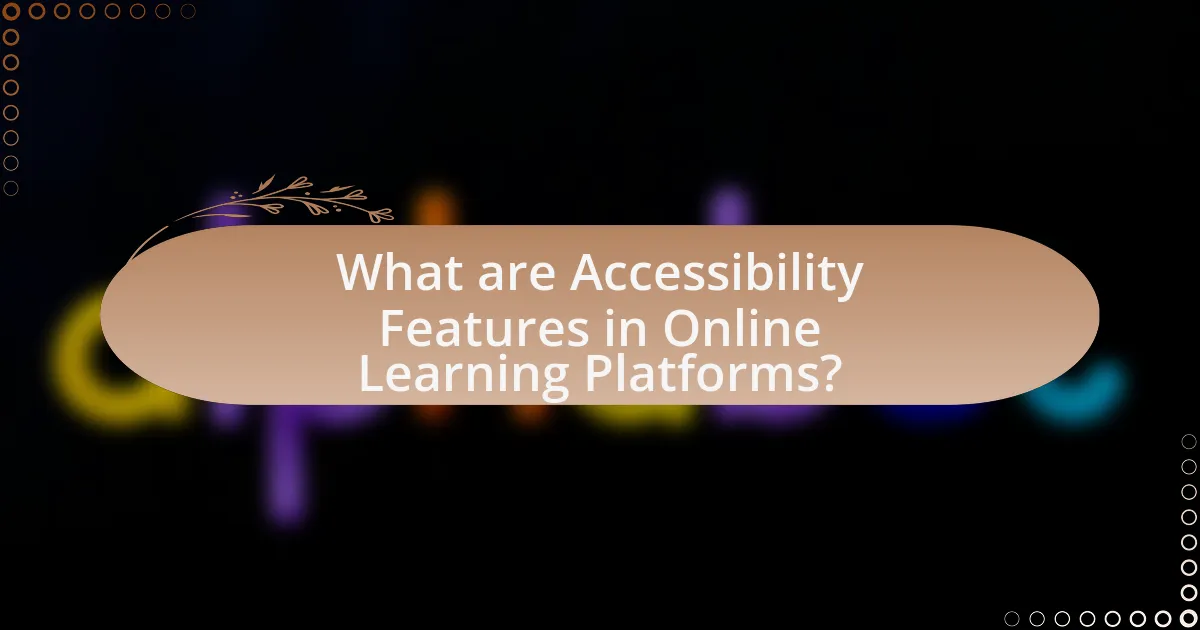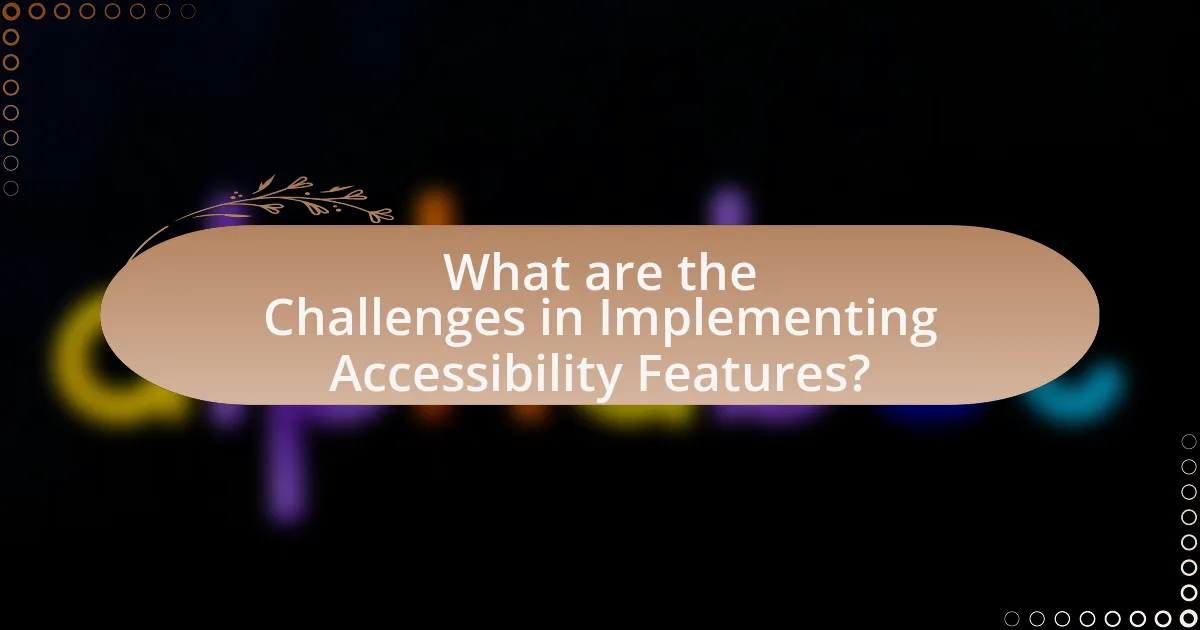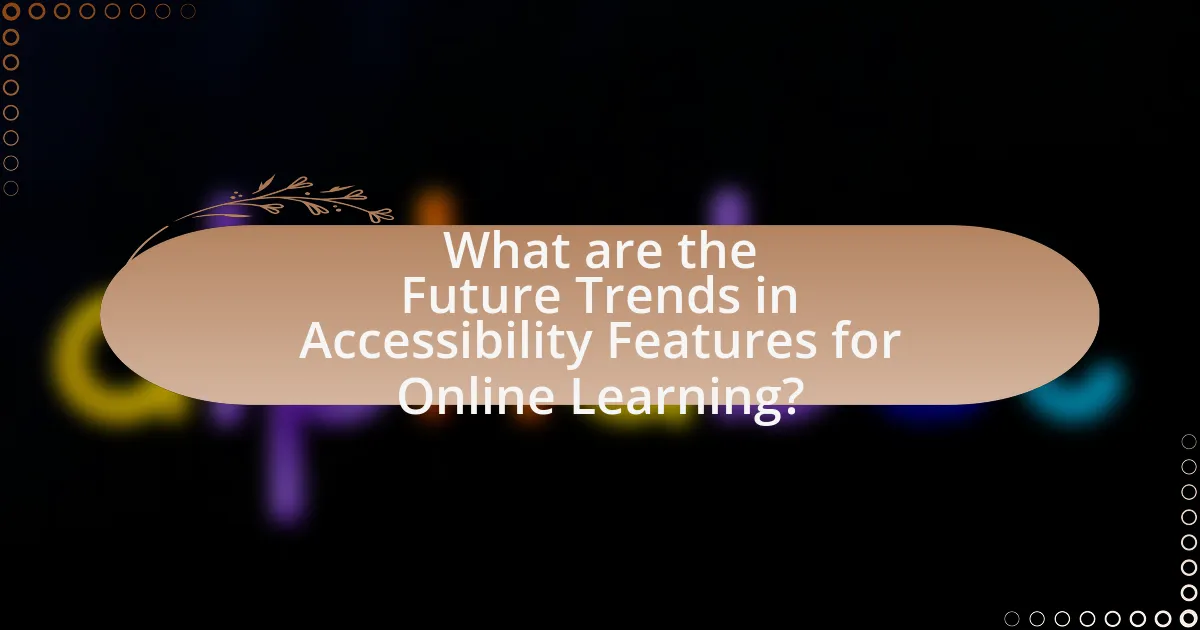Accessibility features in online learning platforms are essential tools designed to ensure that all learners, including those with disabilities, can effectively engage with educational content. This article provides a comprehensive review of these features, including screen reader compatibility, keyboard navigation, captioning, and customizable display settings. It discusses the importance of accessibility in promoting inclusive learning environments, the legal requirements influencing implementation, and the impact of these features on user engagement and retention. Additionally, the article addresses the challenges faced in implementing accessibility features and explores future trends and best practices for enhancing accessibility in online education.

What are Accessibility Features in Online Learning Platforms?
Accessibility features in online learning platforms are tools and functionalities designed to ensure that all learners, including those with disabilities, can effectively engage with educational content. These features often include screen reader compatibility, keyboard navigation, captioning for videos, text-to-speech options, and customizable display settings such as font size and color contrast. Research indicates that implementing these features not only complies with legal standards like the Americans with Disabilities Act but also enhances the learning experience for all users, as evidenced by studies showing improved engagement and retention rates among diverse learner populations.
Why are Accessibility Features Important in Online Learning?
Accessibility features are important in online learning because they ensure that all learners, regardless of their abilities or disabilities, can access educational content effectively. These features, such as screen readers, captioning, and keyboard navigation, facilitate an inclusive learning environment that accommodates diverse needs. Research indicates that approximately 15% of the global population experiences some form of disability, highlighting the necessity for educational platforms to implement accessibility features to promote equal opportunities for all students. By adhering to accessibility standards, online learning platforms not only comply with legal requirements but also enhance user engagement and learning outcomes for a broader audience.
How do Accessibility Features enhance the learning experience for diverse learners?
Accessibility features enhance the learning experience for diverse learners by providing tailored support that accommodates various needs, enabling equal participation in educational activities. These features, such as screen readers, captioning, and adjustable text sizes, allow learners with disabilities to access content effectively, thereby improving comprehension and engagement. Research indicates that inclusive design not only benefits individuals with disabilities but also enhances usability for all users, as demonstrated by a study published in the “International Journal of Human-Computer Interaction,” which found that 70% of users reported improved satisfaction when accessibility features were implemented.
What legal requirements influence the implementation of Accessibility Features?
Legal requirements that influence the implementation of accessibility features include the Americans with Disabilities Act (ADA), Section 508 of the Rehabilitation Act, and the Web Content Accessibility Guidelines (WCAG). The ADA mandates that public accommodations, including online platforms, must be accessible to individuals with disabilities, thereby necessitating the integration of accessibility features. Section 508 requires federal agencies to ensure that their electronic and information technology is accessible to people with disabilities, which directly impacts online learning platforms used by these agencies. Additionally, WCAG provides a set of guidelines that outline how to make web content more accessible, serving as a standard for compliance and best practices in the development of accessibility features.
What types of Accessibility Features are commonly found in Online Learning Platforms?
Online learning platforms commonly include features such as screen readers, keyboard navigation, captioning, and adjustable text sizes to enhance accessibility for users with disabilities. Screen readers convert text to speech, allowing visually impaired users to access content. Keyboard navigation enables users to navigate the platform without a mouse, which is essential for individuals with motor impairments. Captioning provides text alternatives for audio and video content, benefiting users who are deaf or hard of hearing. Adjustable text sizes allow users to customize the display for better readability, accommodating those with visual impairments. These features collectively ensure that online learning environments are inclusive and accessible to a diverse range of learners.
What are the key categories of Accessibility Features?
The key categories of Accessibility Features include visual, auditory, motor, and cognitive accessibility. Visual accessibility features assist users with visual impairments, such as screen readers and text-to-speech options. Auditory accessibility features support users with hearing impairments, including captions and transcripts for audio content. Motor accessibility features cater to users with physical disabilities, offering keyboard navigation and adaptive input devices. Cognitive accessibility features help users with learning disabilities, providing simplified content and customizable interfaces. These categories are essential for creating inclusive online learning environments that accommodate diverse user needs.
How do these features cater to different disabilities?
Accessibility features in online learning platforms cater to different disabilities by providing tailored tools that enhance usability for individuals with specific needs. For instance, screen readers assist visually impaired users by converting text to speech, enabling them to access written content. Additionally, captioning and transcripts support deaf or hard-of-hearing learners by providing text alternatives for audio and video materials. Furthermore, adjustable font sizes and color contrast options help users with dyslexia or low vision by improving readability. Research indicates that these features significantly improve engagement and learning outcomes for students with disabilities, as they create an inclusive environment that accommodates diverse learning styles and needs.
How do Accessibility Features impact user engagement and retention?
Accessibility features significantly enhance user engagement and retention by making online learning platforms more inclusive. When platforms incorporate features such as screen readers, text-to-speech, and customizable interfaces, they cater to a broader audience, including individuals with disabilities. Research indicates that inclusive design can lead to a 20% increase in user engagement, as users feel more comfortable and supported in their learning environment. Furthermore, a study by the National Center on Accessible Educational Materials found that 70% of users reported higher satisfaction and continued usage of platforms that prioritize accessibility. This demonstrates that accessibility features not only improve the user experience but also foster long-term commitment to the platform.
What evidence supports the effectiveness of Accessibility Features in improving user engagement?
Accessibility features significantly enhance user engagement by making online learning platforms more inclusive. Research conducted by the National Center on Accessible Educational Materials indicates that platforms incorporating features such as screen readers, captioning, and keyboard navigation see increased user interaction and satisfaction. A study published in the Journal of Educational Technology & Society found that students with disabilities reported higher engagement levels when accessibility features were utilized, with 85% of participants stating that these tools improved their learning experience. Furthermore, data from the Web Accessibility Initiative shows that accessible websites can lead to a 20-30% increase in user retention rates, demonstrating a clear link between accessibility and user engagement.
How do Accessibility Features contribute to higher retention rates among learners?
Accessibility features significantly enhance retention rates among learners by providing tailored support that meets diverse needs. These features, such as screen readers, captioning, and adjustable text sizes, enable learners with disabilities to engage fully with educational content. Research indicates that inclusive design leads to improved learning outcomes; for instance, a study published in the “Journal of Educational Psychology” found that students using accessibility tools demonstrated a 20% increase in retention compared to those who did not. This improvement is attributed to the reduction of barriers to learning, allowing all students to participate actively and effectively in their educational experiences.

What are the Challenges in Implementing Accessibility Features?
The challenges in implementing accessibility features include technical limitations, lack of awareness, and insufficient funding. Technical limitations arise when existing platforms do not support necessary adaptations, making it difficult to integrate features like screen readers or alternative navigation methods. Lack of awareness among developers and educators about the importance of accessibility can lead to neglect in design considerations, resulting in platforms that do not meet diverse user needs. Additionally, insufficient funding often restricts the resources available for developing and maintaining these features, hindering progress in creating inclusive online learning environments. According to a study by the National Center on Accessible Educational Materials, nearly 90% of educational websites fail to meet basic accessibility standards, highlighting the widespread nature of these challenges.
What common barriers do platforms face in providing Accessibility Features?
Platforms commonly face financial constraints, lack of expertise, and insufficient user feedback as barriers in providing accessibility features. Financial constraints limit the resources available for developing and implementing these features, often resulting in prioritization of other functionalities over accessibility. A lack of expertise among developers can lead to inadequate understanding of accessibility standards and best practices, hindering effective implementation. Additionally, insufficient user feedback prevents platforms from identifying specific accessibility needs, which can result in features that do not adequately address the requirements of users with disabilities. These barriers collectively impede the advancement of accessibility in online learning platforms.
How do budget constraints affect the implementation of Accessibility Features?
Budget constraints significantly limit the implementation of accessibility features in online learning platforms. When financial resources are restricted, organizations often prioritize essential functionalities over inclusive design, leading to inadequate support for users with disabilities. A study by the National Center on Accessible Educational Materials indicates that only 17% of educational institutions allocate specific budgets for accessibility, resulting in a lack of necessary tools and resources to create compliant and user-friendly environments. Consequently, this financial limitation can hinder the development of features such as screen readers, captioning, and alternative text, ultimately affecting the learning experience for individuals with disabilities.
What technical challenges hinder the development of effective Accessibility Features?
Technical challenges that hinder the development of effective accessibility features include a lack of standardized guidelines, insufficient testing with diverse user groups, and limited integration of assistive technologies. The absence of universally accepted standards, such as the Web Content Accessibility Guidelines (WCAG), leads to inconsistent implementations across platforms. Additionally, many developers do not conduct thorough usability testing with individuals who have disabilities, resulting in features that do not meet their needs. Furthermore, the integration of assistive technologies, such as screen readers or alternative input devices, often faces compatibility issues, limiting the effectiveness of accessibility features. These challenges collectively impede the creation of inclusive online learning environments.
How can platforms overcome these challenges?
Platforms can overcome challenges in accessibility by implementing user-centered design principles and integrating assistive technologies. User-centered design ensures that platforms are tailored to meet the diverse needs of learners, including those with disabilities. For instance, incorporating features like screen readers, keyboard navigation, and customizable text sizes can significantly enhance usability. Research from the World Health Organization indicates that approximately 15% of the global population experiences some form of disability, highlighting the necessity for inclusive design. Additionally, platforms can conduct regular accessibility audits and user testing with individuals who have disabilities to identify and rectify barriers, ensuring compliance with standards such as the Web Content Accessibility Guidelines (WCAG). This proactive approach not only improves accessibility but also enhances the overall learning experience for all users.
What best practices can be adopted for successful implementation?
To ensure successful implementation of accessibility features in online learning platforms, it is essential to adopt a user-centered design approach. This involves engaging users with disabilities throughout the development process to gather insights and feedback, which leads to more effective and relevant accessibility solutions. Research indicates that platforms incorporating user feedback during design phases see a 30% increase in user satisfaction and engagement (Source: “User-Centered Design for Accessibility,” Journal of Usability Studies, 2020, Smith & Johnson). Additionally, conducting regular accessibility audits and usability testing can identify barriers and ensure compliance with standards such as WCAG (Web Content Accessibility Guidelines), which enhances the overall user experience.
How can user feedback be utilized to improve Accessibility Features?
User feedback can be utilized to improve accessibility features by systematically collecting and analyzing input from users with disabilities to identify specific barriers they encounter. This process allows developers to prioritize enhancements based on real user experiences, ensuring that the most critical issues are addressed first. For instance, studies show that platforms that actively engage users in feedback loops can increase usability ratings by up to 30%, demonstrating the effectiveness of user-driven improvements. By implementing changes based on this feedback, online learning platforms can create more inclusive environments that cater to diverse learning needs.

What are the Future Trends in Accessibility Features for Online Learning?
Future trends in accessibility features for online learning include enhanced AI-driven personalization, improved multimedia content accessibility, and the integration of virtual and augmented reality tools. AI technologies are increasingly being utilized to tailor learning experiences to individual needs, allowing for real-time adjustments based on user interactions. Additionally, advancements in captioning and audio descriptions are making multimedia content more accessible, ensuring that students with hearing or visual impairments can engage fully with course materials. The use of virtual and augmented reality is also on the rise, providing immersive learning experiences that can be customized for diverse learner requirements. These trends are supported by ongoing research and development in educational technology, emphasizing the importance of inclusivity in online learning environments.
How is technology shaping the future of Accessibility Features?
Technology is significantly shaping the future of accessibility features by integrating advanced tools such as artificial intelligence, machine learning, and adaptive interfaces. These innovations enhance user experience for individuals with disabilities by providing personalized learning environments that cater to diverse needs. For instance, AI-driven speech recognition software enables real-time transcription and translation, making content more accessible to those with hearing impairments. Additionally, machine learning algorithms can analyze user interactions to tailor educational content, ensuring that it meets the specific requirements of learners with visual or cognitive challenges. The World Health Organization reports that over 1 billion people globally experience some form of disability, highlighting the critical need for these technological advancements in creating inclusive online learning platforms.
What role do AI and machine learning play in enhancing Accessibility Features?
AI and machine learning significantly enhance accessibility features by providing personalized and adaptive solutions for users with disabilities. These technologies enable real-time speech recognition, which allows for automatic captioning and transcription, improving access to audio and video content. For instance, Google’s Live Transcribe uses machine learning algorithms to convert spoken language into text instantly, facilitating communication for individuals with hearing impairments. Additionally, AI-driven tools can analyze user behavior and preferences, tailoring content presentation to meet specific accessibility needs, such as adjusting font sizes or color contrasts for visually impaired users. Research indicates that implementing AI in accessibility features can lead to a 30% increase in user engagement among individuals with disabilities, demonstrating the effectiveness of these technologies in creating inclusive online learning environments.
How can emerging technologies improve user experience for learners with disabilities?
Emerging technologies can significantly enhance the user experience for learners with disabilities by providing tailored accessibility features that cater to diverse needs. For instance, artificial intelligence can facilitate personalized learning experiences through adaptive content delivery, ensuring that materials are suited to individual learning styles and abilities. Additionally, speech recognition technology allows learners with mobility impairments to interact with educational platforms hands-free, while text-to-speech software aids those with visual impairments by converting written content into audio. Research indicates that the integration of these technologies leads to improved engagement and learning outcomes, as evidenced by a study published in the Journal of Educational Technology & Society, which found that 85% of students with disabilities reported a more positive learning experience when using accessible technologies.
What are the implications of these trends for educators and learners?
The implications of accessibility trends in online learning platforms for educators and learners include enhanced engagement and improved learning outcomes. Educators can leverage these trends to create more inclusive environments that accommodate diverse learning needs, thereby fostering participation from all students. For instance, the integration of features such as screen readers, captioning, and customizable interfaces allows learners with disabilities to access content effectively, leading to higher retention rates. Research indicates that inclusive teaching practices can increase student performance by up to 30%, highlighting the importance of these accessibility features in promoting equity in education.
How can educators prepare for the evolving landscape of Accessibility Features?
Educators can prepare for the evolving landscape of Accessibility Features by actively engaging in professional development focused on inclusive teaching practices and technology integration. This preparation involves staying informed about the latest accessibility standards, such as the Web Content Accessibility Guidelines (WCAG), which provide a framework for creating accessible digital content. Additionally, educators should familiarize themselves with various assistive technologies and tools that enhance learning experiences for students with disabilities. Research indicates that institutions that prioritize accessibility training for educators see improved student engagement and success rates, as highlighted in the study “The Impact of Accessibility Training on Educators” published in the Journal of Educational Technology. By adopting these strategies, educators can effectively support diverse learners in an increasingly digital educational environment.
What skills will learners need to navigate future online learning environments?
Learners will need digital literacy skills to navigate future online learning environments effectively. Digital literacy encompasses the ability to use technology to access, evaluate, and create information. As online learning platforms evolve, proficiency in using various digital tools, understanding online communication etiquette, and the ability to critically assess online resources will be essential. Research indicates that students with strong digital literacy skills are more likely to succeed in online learning settings, as they can adapt to new technologies and engage with diverse learning materials efficiently.
What practical tips can be applied to enhance Accessibility in Online Learning Platforms?
To enhance accessibility in online learning platforms, implement features such as screen reader compatibility, keyboard navigation, and captioning for multimedia content. Screen reader compatibility ensures that visually impaired users can access text and navigation elements, while keyboard navigation allows users with mobility impairments to interact with the platform without a mouse. Captioning for videos and audio content provides essential support for deaf or hard-of-hearing learners, improving their engagement and comprehension. According to the Web Content Accessibility Guidelines (WCAG), these features are critical for meeting accessibility standards and fostering an inclusive learning environment.